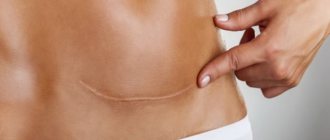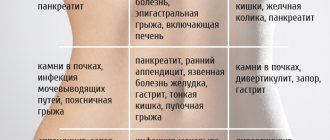In the information age, we are bombarded with hundreds of shopping offers every moment. If we can postpone the purchase of things and think about it, then food advertising can bribe us right now. Well, how can you pass up aromatic pastries, especially if you’re hungry and running to lunch? Don't forget that food is a way to cheer yourself up.
In a work schedule, it is not always possible to maintain a diet and set aside the same time for lunch. Having finally forced ourselves to have lunch, when the feeling of hunger is at its limit, we take larger portions than we need, or in general all at once, because we cannot adequately assess our strength. After such a “raid” to the dining room, you may encounter heaviness after eating or discomfort in the stomach. Thoughts about proper nutrition and adherence to the regime come to everyone, but implementing them is not so easy.
Why does the lower abdomen hurt and what to do about it?
The uterus is the most important organ of the reproductive system of every woman. The most common complaint in gynecologist practice is pain in the lower abdomen. This symptom can occur with various diseases (endometriosis, menstruation, the presence of tumors, etc.). Pain in the lower abdomen can develop with an enlarged uterus, which puts pressure on neighboring organs - the bladder, intestines. If you experience pain in the lower abdomen, you should immediately consult a gynecologist to determine the causes of the pain and prescribe the necessary treatment.
The secret of digestion
Our digestive system works without interruption. It helps absorb vitamins, nutrients, remove unnecessary substances and toxins. It doesn’t matter what you swallow - a unhealthy bun or a healthy leaf of lettuce, the body’s task is to digest it and extract the maximum benefit. The most important role in this process is played by enzymes - special substances that disassemble food into its component parts like a construction set.
The pancreas plays a special role in this process. It is she who produces enzymes. And not just one, but a whole complex.
Each enzyme has its own purpose. Amylase digests carbohydrates, protease digests proteins, and lipase breaks down fats. Lipase stands out among them in that only the pancreas can produce it4.
When the pancreas fails to cope and there are fewer enzymes than needed for proper digestion, problems can arise. Food may not be completely digested, and the body may not receive enough nutrition. Heaviness may appear after eating, abdominal discomfort, bloating, gases from fermentation of undigested contents, and bowel movements may be disrupted4.
As we can see, this situation can arise with any type of diet from normal to very healthy. Much will depend on the functioning of the pancreas.
Causes of pain in the lower abdomen
The main causes of pain in the lower abdomen are as follows:
- Menstruation. Pain during menstruation is called dysmenorrhea. Dysmenorrhea can be primary (passes with the end of menstruation) and secondary (occurs against the background of an inflammatory process).
- Gynecological inflammatory diseases (adnexitis, endometritis, salpingitis, etc.). Most often accompanied by severe, aching pain that regularly bothers you. Other symptoms also appear, such as heavy discharge, a constant urge to urinate, a burning sensation and itching.
- Malignant formations;
- The presence of an ovarian cyst and symptomatic uterine fibroids;
- Endometriosis (a disease that damages the internal tissue of the uterus - the endometrium);
- Abortion;
- Consequences of inserting an intrauterine device.
If I don't understand my emotions
If we remember the three languages - thoughts, emotions and sensations in the body - it happens that people seem to be “disconnected” between these three languages and cannot or do not know how to combine them into one whole:
- he simply doesn’t know that it’s the same thing “in different languages” and gets scared;
- grew up in a family where experiencing emotions was not encouraged, so he was not told anything about it and was told that feelings should be suppressed;
- I’ve never asked such questions before; there were other things to do.
If you are interested in getting to know yourself better, then here it is, one of the wonderful ways of self-development: learning to hear and understand the different languages of your feelings .
Sometimes it happens that you don’t immediately realize what thoughts or emotions you have, and it’s easier to notice physical sensations in the body. If this is your case, then it is useful to know what other sensations there are:
- “vice” on the temples - anxiety, anger
- seething, jumping in the stomach - anxiety, fear, expectation of bad things
- fluttering in the stomach, “butterflies”, tickling - anxiety, anticipation, curiosity mixed with joy, especially if something important is coming up
- heart beats, thumps, jumps - fear, anxiety, anger, excitement
- stomach twisted, sharply squeezed, as if hit in the gut - sudden shock, fear, excitement, sharp and unexpected feeling
- stiffness, stiffness, numbness, stone - anger, unfriendliness, anxiety, reluctance to feel
- clenched jaws - anger, resentment
- shuddered, felt sick - disgust
- shuddered, twitched - sudden surprise, pain, fear
- hot and cold flashes alternately - anxiety, embarrassment
- face burns - anger, shame
- itching, something itches - anxiety, shame, anger
- tingling of the skin, goosebumps - some kind of emotion, also expectation of something
- tears appeared - resentment, sadness, sadness
- cottony hands and feet - anxiety, fear
- trembling throughout the body - either cold, or a strong emotion, for example, fear, anxiety
- hands or head are shaking
- heaviness throughout the body - depression, depression, impotence
- coldness throughout the body or in the chest - fear, loneliness, depression
- lump in throat - sadness, sadness, you can’t say something
- lump in the stomach - anxiety
- feeling of emptiness inside - depression, melancholy, sadness, loneliness
- sweating - anger, fear
- breathing has changed - some kind of emotion
- lightness throughout the body - joy, happiness, hope
- breathe easier - relief, joy
- on the same topic: physical symptoms of social phobia, or severe anxiety
If at any moment you can understand that something has changed in your body, assume that you are experiencing some kind of emotion. Ask yourself which one, and you will learn to be in touch with yourself.
Also, for those who find it difficult to name emotions in words, a list of emotions can help; you can print it out or save it to your smartphone and from time to time check what it is you are feeling there right now.
Diaries for independent CBT psychotherapy
Helps work with self-confidence, self-esteem, anxiety, depression.
Developed by a psychologist
LOOK
So, sensations in the body during emotions can be varied, and this is all normal. There is no way to get rid of them. Other people have the same story. Identify how you personally experience different emotions to better understand yourself and what is happening.
Once again, thank you to everyone who sent in their responses to my survey.
Together we are engaged in psychoeducation, and this is one of the most important parts of psychotherapy. 1Nummenmaa L, Glerean E, Hari R, Hietanen JK. Bodily maps of emotions. Proc Natl Acad Sci US A. 2014;111(2):646-651. doi:10.1073/pnas.1321664111
Symptoms
Various diseases of the female reproductive system cause severe muscle spasms, which lead to pain in the lower abdomen. The pain can be sharp, nagging, aching, growing and recurring regularly. After a detailed examination, the doctor will be able to establish the correct diagnosis and prescribe treatment.
If you experience similar symptoms, we advise you to make an appointment with a gynecologist at the Federal Scientific Center for Medical and Biological Agency. Timely diagnosis will prevent negative consequences for your health!
Diagnostics
Diagnosing the causes of a feeling of heaviness inside the abdomen and pain can sometimes be quite difficult, since pain can appear due to various diseases. To determine the cause of pain, it is extremely important to initially identify the disease that led to such pain. To do this, you need to make an initial appointment with a gynecologist. The doctor, based on the results of an in-person examination, will make initial assumptions about a possible diagnosis and prescribe the necessary diagnostic and laboratory tests.
Diagnostics includes:
- In-person examination by a specialized specialist (history collection);
- Gynecological examination;
- Ultrasound of the pelvic organs (a study that can help detect dysfunction of the reproductive system organs);
- MRI of the uterus (a research method to determine the presence of tumors);
- Colposcopy (examination of the surface of the cervix using a colposcope).
Laboratory tests include:
- Flora smear;
- Cytological examination of a cervical smear;
- Femoflor (to exclude sexually transmitted infections);
- General blood analysis;
- General urine analysis;
- Blood chemistry;
- Blood test for HIV, hepatitis, syphilis.
Pain in the uterus can be a manifestation of various diseases, therefore, first of all, it is necessary to identify the underlying disease, and only then begin treatment. The treatment plan is selected for each patient by a gynecologist individually, depending on the nature of the pain, the primary disease and the condition of the body. The FSCC FMBA has developed a special comprehensive program for checking women's health. The program will help to identify hidden pathologies that cause pain and assess the condition of the woman’s reproductive system.
Using the example of experiencing anger
Let's look at this complex reaction using the example of the experience of anger.
As three different languages tell us about this:
- “She has no right to do this! This is TERRIBLY unfair!” - thought
- Feels anger, irritation, anger - emotions
- Your shoulders and arms are tense, your heart is pounding—these are sensations in your body .
This is how they described their feelings when they were angry in my survey:
It burns in your chest, your face burns, and you break into a sweat.
Rapid heartbeat, hot head, sometimes leading to migraine, tension in the arms - especially in the hands.Fists clench, arms and legs tremble, teeth clench, breathing intensifies.
A rush of blood or negative energy to the head.
Look at the heat map of a person in anger: all the energy went up and into the hands.
Diaries for independent CBT psychotherapy
Helps work with self-confidence, self-esteem, anxiety, depression.
Developed by a psychologist
LOOK
Treatment of lower abdominal pain
Pain in the lower abdomen can be caused by various reasons (endometriosis, menstruation, inflammatory diseases, cysts, etc.); to select the optimal treatment method, you first always need to determine the root cause of the pain. Self-medication for such pain is contraindicated.
Thus, for severe inflammatory diseases (adnexitis, endometritis, inflammatory ovarian cysts, etc.), as a rule, drug antibacterial therapy is prescribed. Your doctor may also recommend taking medications to improve your immune system. Surgical treatment for inflammatory diseases leading to pain in the lower abdomen is rarely used. However, in some cases, doctors may resort to surgery. During the intervention, gynecologists find pockets of pus, drain and wash them. Pain during menstruation can be relieved at home. To get rid of pain in the lower abdomen, you need to apply a warm compress for 15 minutes, take a painkiller and stay in bed. If the pain during menstruation is very strong and causes discomfort, you should immediately consult a gynecologist to determine the cause of the pain, because pain can be caused by various diseases of the reproductive system. If pain in the uterus is caused by diseases such as uterine fibroids or endometriosis, surgical treatment is prescribed. Operations are usually performed minimally invasively (through a minimal incision near the umbilical area). This method of performing surgical intervention does not leave behind visible scars and scars and allows you to quickly cope with the cause of the pain syndrome.
Only a gynecologist can select the most appropriate method of treating pain after a complete examination of the patient and determining the cause of the pain. Each disease requires careful treatment and an integrated approach. Doctors of the Federal Scientific and Clinical Center FMBA have extensive experience in the treatment of diseases of the reproductive system and regularly undergo internships in leading European clinics.
How to help digestion?
It is possible, and sometimes necessary, to support digestion. Science has long found a solution. So, back in the last century, enzyme preparations were born, the use of which helps to compensate for the lack of one’s own enzymes and aid digestion.
However, the optimal solution was not found immediately. At first, most of the drugs were destroyed along the way, in the stomach. Then special shells were created to protect them. But the progress did not stop there5.
A key factor in the effectiveness of enzyme preparations was identified. Surprisingly, it turned out to be the particle size: the smaller it is, the more effective the drug will be1,2. Thanks to this discovery, the drug Creon® appeared in its modern form.
It is based on minimicrospheres - a special form in the form of small particles. They are placed in a capsule, but in addition, each mini-microsphere itself is in a reliable protective shell in order to pass through the stomach and be activated in the intestines. It is not by chance that they talk about the intestines: contrary to popular belief, the main digestion of food occurs in the intestines, and not in the stomach!
How Creon® 10000 helps digestion:
- in the stomach, the capsule quickly dissolves, and minimicrospheres are evenly distributed in food3;
- particles accompany each portion of food entering the intestines;
- activated after entering the intestines after 15 minutes1;
- the drug is naturally integrated into its own digestion3,4;
- the body does not stop digesting food on its own, but only receives the necessary support4.
To learn more
This action fundamentally distinguishes Creon® from similar drugs in tablet form (even the instructions say that 2-4 pieces may be required at a time)6. Creon® 10000 helps food to be fully digested to cope with heaviness and discomfort after eating3. Usually, 1 capsule of Creon® 100003 is enough. The safety of the drug can be judged by the fact that it is approved for use even in infants3.
You can read more about the benefits of Creon® here.










